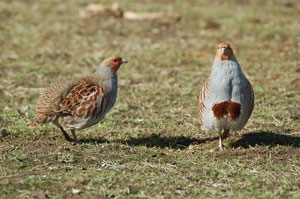 Farmers, land managers and gamekeepers are being invited to gain a better understanding of the state of wildlife on their land by joining the national Partridge Count Scheme (PCS).
Farmers, land managers and gamekeepers are being invited to gain a better understanding of the state of wildlife on their land by joining the national Partridge Count Scheme (PCS).
“Understanding how grey partridge are faring can give you a clearer picture of the health of your land,” says Neville Kingdon, who runs the Partridge Count Scheme for the Game & Wildlife Conservation Trust (GWCT). “Our research shows that if partridges are thriving then other species will too.”
The voluntary, free-to-join scheme asks those taking part to spend a few hours counting the wild grey partridges on their land in the spring and autumn. The grey partridge is considered a farmland biodiversity Indicator species – it is barometer for wider farmland biodiversity. Where wild grey partridges are doing well, so will many other species. Counts can also provide an early warning of a problem, enabling land managers to make necessary changes.
The Partridge Count Scheme has been keeping track of wild grey partridges on Britain’s farmland since 1933. The species has suffered a sharp decline in the UK since the 1970s. Every year volunteers are given guidance on how and when to count and the data they collect is submitted to the GWCT, helping their research. In return, they receive site-specific results, which can help identify which factors might be limiting partridges on their land and inform their habitat management plans. Future counts will then help to track the success of those measures, modifying them when needed and further encouraging land managers in their commitment to conservation.
“Those who manage the land are crucial, not just to how the partridge and other wildlife fare, but to understanding what is happening on a local and national level,” continues Neville Kingdon. “We are looking for more volunteers because the more counts we get back, the more we can do to reverse the decline in this important bird species.”
Counts are carried out in the spring to measure breeding abundance and in the autumn to measure breeding success. For grey partridges, the best time of day to count is around dawn and dusk when birds are out of cover and feeding. Landowners who have just a handful of partridges are strongly encouraged to sign up to the scheme.
“Understanding where there are still a few wild grey partridges helps those involved to better identify any issues that may be preventing their numbers improving and which measures they can take to help. There are thousands of farms across the country who still have a pair or two holding on. If we could help each to increase their wild partridge numbers to four or five pairs, or possibly more, that would go a long way towards reversing the huge decline in grey partridges in all areas of the country,” says Neville.
For more information or to join the Partridge Count Scheme, please visit www.gwct.org.uk/pcs.
Notes to editors
The Game & Wildlife Conservation Trust – providing research-led conservation for a thriving countryside. The GWCT is an independent wildlife conservation charity which has carried out scientific research into Britain’s game and wildlife since the 1930s. We advise farmers and landowners on improving wildlife habitats. We employ 22 post-doctoral scientists and 50 other research staff with expertise in areas such as birds, insects, mammals, farming, fish and statistics. We undertake our own research as well as projects funded by contract and grant-aid from Government and private bodies. The Trust is also responsible for a number of Government Biodiversity Action Plan species and is lead partner for grey partridge and joint lead partner for brown hare and black grouse.
For information, contact:
Eleanor Williams
Telephone: 07592 025476
Email: press@gwct.org.uk